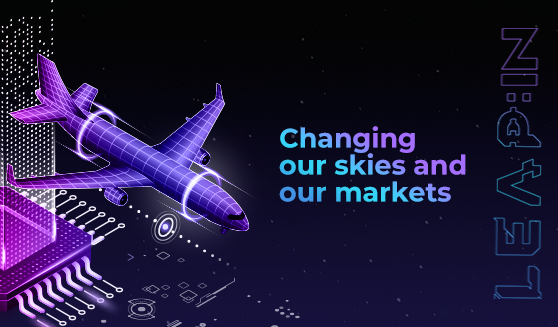

Changing our skies and our markets

We’re winding down from #LEAP23 and keeping the magic alive by interviewing some of our incredible keynote speakers, exclusively for the LEAP blog and newsletter. Here’s a little bit of what they’ve shared with us.
This week we’re quoting…
Sofia Graflund (Chief Operating Officer at Heart Aerospace)
What Graflund said:
“In our journey towards entry into service in 2028 we need to be transparent towards the general public and highlight the fact that flying in a certified airplane is the safest mode of transport.”
Journey to entry?
Graflund was talking about electric aviation, and how to build passengers’ trust in this new form of air travel. Electric air taxis and larger electric aircraft, such as the 30-seater planes in development by Heart Aerospace, are expected to be in the skies within the next few years.
Safety + CO2
Indeed, research on existing air travel shows that it has long been the safest way to get around – like this study of transport fatalities in the US between 2000 and 2009.
But safe as it may be, the global aviation industry is responsible for 12% of CO2 emissions from all transport sources, according to data from the Air Transport Action Group. This is nothing compared to road transport (74%) but it could be better: and electric air travel will make it better.
One UK-based study commissioned by electronics distributor Distrelec analysed a total of 100 flights that departed from UK airports. Based on that data, researchers estimate that 2.7 million tonnes of CO2 could be saved if the UK made all its domestic flights electric.
And this white paper by the International Council on Clean Transportation found that electric aircraft could enable between 49% and 88% reduction in CO2 emissions compared with fossil-fueled aircraft – factoring in the carbon intensity of battery production (which accounts for as much as 80% of GHG emissions from electric aircraft). Overall, the study found that electric aircraft could ease 3.7 megatonnes of CO2 every year.
Electric aviation will be safe and have a low carbon footprint
Electric aircraft, including those in development by Heart Aerospace, will be certified to the same safety standards as fossil-fueled aircraft – the requirements will be just as stringent.
Electric aviation, then, will offer both of these major benefits to humanity: it’ll be a safe form of transport with a low carbon footprint.
Read the interview: Electrified air travel by 2028
This week we’re also quoting…
Ana Barjasic (Founder and CEO at Connectology)
What Barjasic said:
“Innovative entrepreneurs are critical for creative problem-solving that changes and benefits societies globally.”
We couldn’t agree more
Entrepreneurs are important. They’re brave, creative, innovative people with the vision to look at the world around them with fresh eyes – and then do something to change it.
Some quick stats on entrepreneurship right now:
- There are approximately 528 million entrepreneurs in the world (source: Thinkimpact)
- Of those, 274 million are female. Angola has the highest rate of female entrepreneurship in the world (51.1% of the adult female population), followed by Panama (29.1%) and then Saudi Arabia (17.7%) (source: GEM Consortium)
- In the US, about 63% of entrepreneurs are making a profit (source: Guidant Financial)
- Entrepreneurship isn’t just for fearless young things. The majority of early-stage entrepreneurial activity happens in the 45-54 age group, followed by older entrepreneurs (55-64) – and those aged 20-34 are the least likely to start new businesses (source: Kauffman)
The agility of entrepreneurs
Lots of big businesses have been working to flatten their hierarchical structures to create greater democracy and flexibility over the last few years – including Google. One of the superpowers of entrepreneurs is that less hierarchy is a part of their makeup – they start small businesses and build teams from the ground up, and that means they have the capacity to be highly agile.
Without complex hierarchical structures, team members can delegate tasks across the business and deploy the talent wherever it’s most effective at any given moment. Everyone has responsibility and the option to lead – so when unexpected changes happen in the business, or in the market, it’s easy (ish) to adapt.
By extension, entrepreneurs can also help their societies adapt to global political and environmental changes with innovative solutions to shared problems.
At LEAP, we think entrepreneurs will be the key to enabling humanity to thrive in the future.
Read our interview with Ana Barjasic: What is ‘investment readiness’?


1.5TB of stunning space data from the James Webb Space Telescope
Get some perspective from 800,000 galaxies

Related
articles


1.5TB of stunning space data from the James Webb Space Telescope
Get some perspective from 800,000 galaxies

